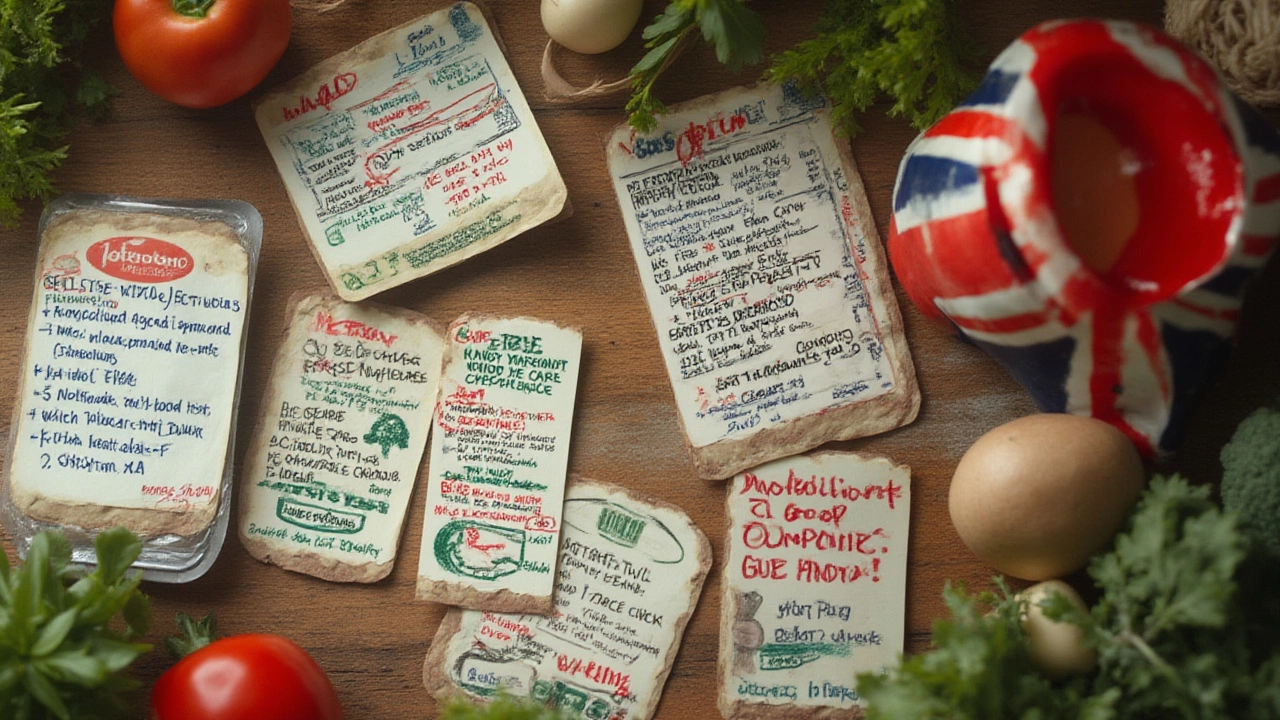Some people think vegetarians eat everything except obvious meat. The reality is a lot sneakier. Even French fries can hide animal products. Restaurants love tossing bacon bits onto salads as if they're decorations. And food companies? They crush bugs for food coloring and throw gelatin into anything that jiggles. If you think scanning for steak is enough, get ready to rethink your shopping habits. Vegetarians follow a simple rule: no flesh from animals, but what counts as “animal” is a lot wider than you might expect.
Beyond Meat: A Clear Look at What Vegetarians Won't Eat
Let's start simple: vegetarians don't eat any meat. That means no beef, pork, chicken, turkey, or fish. Yes, even seafood is off the table for vegetarians—pescatarians eat fish, but that’s a whole different crowd. It also includes “meat byproducts.” Chicken broth in your soup? Sorry, not vegetarian. Gelatin in your candy? That’s made by boiling animal bones and skin. And even foods like marshmallows, soft cheeses, and red-dyed candies can sneak in animal ingredients.
But what about products that come from animals without killing them, like eggs and dairy? Most vegetarians are fine with milk, cheese, yogurt, and eggs. Vegans skip these too, but vegetarians generally don’t. Still, there are exceptions. Some cheeses (especially imported ones) use rennet, which is taken from the stomach lining of calves. Most vegetarians skip those. Parmesan, for example, is almost never strictly vegetarian unless labeled so. Meanwhile, desserts and gummy candies tend to hide gelatin derived from pigs or cows. Even mainstream items like Jell-O, some frosted breakfast cereals, and those ultra-bouncy boba pearls can be sneaky.
The label “natural flavors” is also tricky. It might seem plant-based, but it can include animal substances unless clearly marked as vegetarian. Another example: Worcestershire sauce often has anchovies as a main ingredient, so that bottle in your kitchen might not pass the vegetarian test. If this sounds complicated, it is—especially if you start thinking about how common these hidden ingredients are.
Surprising Animal-Derived Ingredients Lurking in Everyday Foods
The list of sneaky animal-derived ingredients is pretty shocking. Take gelatin, for example. It’s not just in candy—it shows up in yogurt, marshmallows, cakes, and even vitamins. Some juices and beers use a process called isinglass fining, which uses fish bladders to clarify the liquid. You wouldn’t know unless you checked with the manufacturer. Then there’s carmine or cochineal, a red food dye made by crushing insects. Ever picked up a bright red smoothie or strawberry yogurt and wondered about the color? Sometimes it’s just beet juice, but other times it’s bugs.
Cheese is a minefield. As mentioned, rennet from animal stomachs is standard in parmesan, grana padano, gorgonzola, manchego, and other European cheeses. Only cheeses labeled as “vegetarian” use microbial or vegetable rennet. Even some processed cheeses slip in animal enzymes. Look for “vegetarian rennet” on the package, or you can check the website of the Cheese Society for a detailed breakdown.
The world of chips, snacks, and fast food isn’t safe either. Those BBQ chips you love? Some brands use chicken fat or beef extract. Natural flavorings can include animal products, especially in snacks and flavored rice. Desserts present a different challenge: frosted cakes or cookies may use lard in the icing; apple pies sometimes hold animal fat in the crust. Even certain brands of white sugar are processed with bone char, which is exactly what it sounds like. If you're in the U.S., only some brands (like Domino and C&H) process sugar through animal bones. This probably isn't a concern for every vegetarian, but the more you know.
Check out this table for some of the sneakiest ingredients most vegetarians avoid:
| Ingredient | Source | Where It Hides |
|---|---|---|
| Gelatin | Animal bones/skin | Marshmallows, candy, desserts, yogurts |
| Carmine (cochineal) | Insects | Drinks, yogurts, candy, makeup |
| Rennet | Calf stomach | Cheese (parmesan, grana padano, manchego) |
| Lard | Pig fat | Pies, baked goods, tortillas |
| Broth (beef/chicken/fish) | Meat | Soups, rice dishes, sauces |
| Isinglass | Fish bladder | Beer, wine, some juices |
| Animal Enzymes | Meat | Processed cheese, bread |
One thing’s for sure—being a detail-oriented grocery shopper is essential for the vegetarian crowd. It pays to check the ingredients list or even email the food company for clarity. Apps like Is It Vegan or HappyCow can help, but always double-check because formulations change all the time.

Animal Byproducts: Drawing Lines That Aren’t Always Clear
So where do vegetarians draw the line? Some stick to the basics—no meat, poultry, fish, or seafood, plus obvious animal-derived ingredients. Others get more strict as they learn about hidden byproducts. The line moves based on personal beliefs, health reasons, or even misinformation online. For example, honey divides vegetarians. Some are fine with it; others consider it off-limits since it’s an animal byproduct—although that’s a debate that even strict plant-based eaters can’t settle.
Then, you have ingredients that seem harmless but come from animals in roundabout ways. Stearic acid, for example, comes from animal fats or plants, but unless labeled, who knows? Mono- and diglycerides are sometimes plant-based, sometimes animal-derived. You often see these in store-bought bread, ice cream, or processed foods. Lecithin is usually made from soy, but sometimes it’s egg-based.
Even healthy snacks aren’t immune. Yogurt-covered anything often contains gelatin. Pre-shredded cheese can use animal-derived cellulose or anti-caking agents. Certain vitamins come in gelatin capsules. And if you’re eating out, broths, gravies, and sauces can carry unsuspected animal ingredients, no matter how “veggie-friendly” the label looks.
Here’s a quick tip: If a food is labeled as “certified vegetarian” or carries a green V label, it generally follows a stricter protocol. The Vegetarian Society in the UK and similar certification groups in other countries do solid reviews of ingredients and processing steps before applying their stamp of approval. However, packaging in America often isn’t regulated this way, so nothing beats a brief glance at the fine print.
- Eating at restaurants? Always ask if the soup base is veggie broth. Some places call vegetable soup “vegetarian” but add chicken stock for flavor.
- Ordering salad? Double-check there’s no surprise bacon, anchovies (Caesar dressing is notorious), or cheese with animal rennet.
- Baking? Use agar or carrageenan instead of gelatin. These plant-based thickeners do the job just as well for most recipes.
- Shopping for sweets? Smart brands like Annie’s, Surf Sweets, or YumEarth usually print “vegan” or “vegetarian” right on the front to make your life easier.
One thing you never outgrow as a vegetarian is a sense of vigilance. Ask questions, don’t apologize for it, and share what you know. If you’re the only vegetarian at a picnic, a quick heads-up can save someone else from chewing on a half-hidden pork-based ingredient. The biggest hurdle isn’t always the food—it’s convincing non-vegetarians that meatless doesn’t mean bland or flavorless.
Tips for Spotting Hidden Animal Ingredients in Food
If you want to stick with a vegetarian diet, it pays to stay sharp. Manufacturers love to hide animal products in fancy-sounding terms. Here are some practical tips that work whether you’re new to vegetarianism or buying snacks for a vegetarian friend:
- Always read the label. Ingredient lists are your first line of defense. Small print, but mighty power.
- Watch out for terms like "gelatin," "rennet," "carmine," "lard," and "anchovy/extract." These are dead giveaways—pun intended.
- Keep an eye on parenthesis. Ingredients in parentheses often reveal the real source, like “enzymes (animal, microbial).”
- Download a reliable scanning app. Some let you scan barcodes and tell quickly if an item is veg-friendly.
- Trust—but verify—markings like “suitable for vegetarians.” Not all claims are regulated in every country.
- Remember, even health supplements and prescription medicines might have animal ingredients in the capsules or binders. Always check with your doctor or pharmacist for alternatives if this matters to you.
- Some “mock” meats are plant-based, while others have egg or milk. Always check packaging for those extra details.
- If you're unsure about a food, type the brand and product name into a vegetarian forum or a social media group. Crowdsourcing has saved many vegetarians from surprise bacon bits.
In a move that surprised a lot of vegetarians, a 2023 survey found that up to 60% of vegetarians had accidentally eaten animal-derived products in the past year, mostly because of tricky packaging or eating out. Don’t let that make you paranoid—just be aware it’s a common experience and use it as a learning moment instead of a reason to give up.
It’s not about perfection—it’s about intention and informed choices. Making a habit of flipping over the package, reading the fine print, or choosing restaurants with clear veggie options is way easier now than it was even five years ago. That means vegetarians today have more options than ever, if they’re willing to spend an extra minute checking the label. Armed with tricks and a sharper eye, skipping meat and animal byproducts doesn’t have to mean sacrificing taste, variety, or fun at the dinner table.

